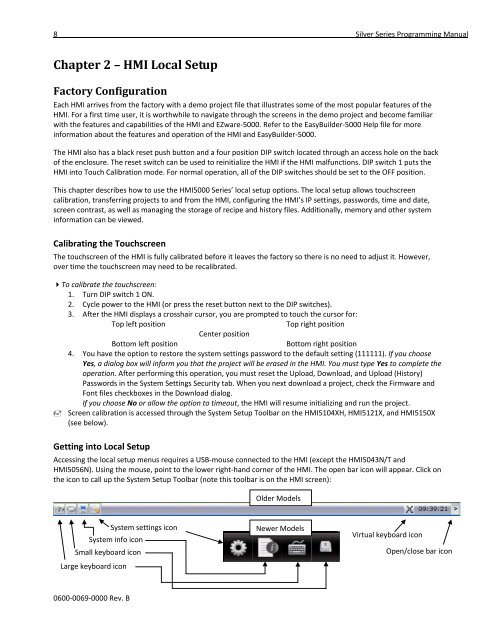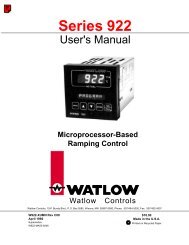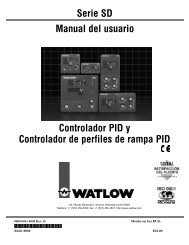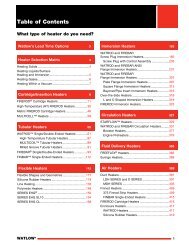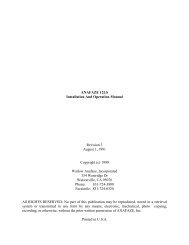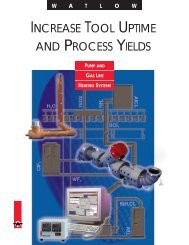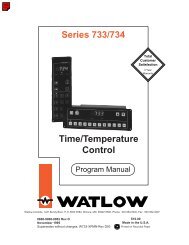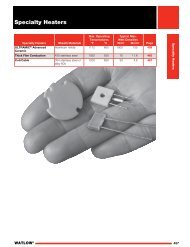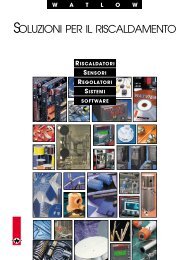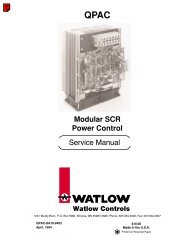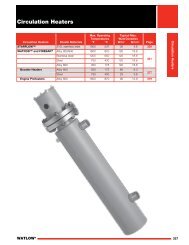Silver Series Installation and Operation Manual, Rev B ... - Watlow
Silver Series Installation and Operation Manual, Rev B ... - Watlow
Silver Series Installation and Operation Manual, Rev B ... - Watlow
You also want an ePaper? Increase the reach of your titles
YUMPU automatically turns print PDFs into web optimized ePapers that Google loves.
8 <strong>Silver</strong> <strong>Series</strong> Programming <strong>Manual</strong>Chapter 2 – HMI Local SetupFactory ConfigurationEach HMI arrives from the factory with a demo project file that illustrates some of the most popular features of theHMI. For a first time user, it is worthwhile to navigate through the screens in the demo project <strong>and</strong> become familiarwith the features <strong>and</strong> capabilities of the HMI <strong>and</strong> EZware-5000. Refer to the EasyBuilder-5000 Help file for moreinformation about the features <strong>and</strong> operation of the HMI <strong>and</strong> EasyBuilder-5000.The HMI also has a black reset push button <strong>and</strong> a four position DIP switch located through an access hole on the backof the enclosure. The reset switch can be used to reinitialize the HMI if the HMI malfunctions. DIP switch 1 puts theHMI into Touch Calibration mode. For normal operation, all of the DIP switches should be set to the OFF position.This chapter describes how to use the HMI5000 <strong>Series</strong>’ local setup options. The local setup allows touchscreencalibration, transferring projects to <strong>and</strong> from the HMI, configuring the HMI’s IP settings, passwords, time <strong>and</strong> date,screen contrast, as well as managing the storage of recipe <strong>and</strong> history files. Additionally, memory <strong>and</strong> other systeminformation can be viewed.Calibrating the TouchscreenThe touchscreen of the HMI is fully calibrated before it leaves the factory so there is no need to adjust it. However,over time the touchscreen may need to be recalibrated.To calibrate the touchscreen:1. Turn DIP switch 1 ON.2. Cycle power to the HMI (or press the reset button next to the DIP switches).3. After the HMI displays a crosshair cursor, you are prompted to touch the cursor for:Top left positionTop right positionCenter positionBottom left positionBottom right position4. You have the option to restore the system settings password to the default setting (111111). If you chooseYes, a dialog box will inform you that the project will be erased in the HMI. You must type Yes to complete theoperation. After performing this operation, you must reset the Upload, Download, <strong>and</strong> Upload (History)Passwords in the System Settings Security tab. When you next download a project, check the Firmware <strong>and</strong>Font files checkboxes in the Download dialog.If you choose No or allow the option to timeout, the HMI will resume initializing <strong>and</strong> run the project. Screen calibration is accessed through the System Setup Toolbar on the HMI5104XH, HMI5121X, <strong>and</strong> HMI5150X(see below).Getting into Local SetupAccessing the local setup menus requires a USB-mouse connected to the HMI (except the HMI5043N/T <strong>and</strong>HMI5056N). Using the mouse, point to the lower right-h<strong>and</strong> corner of the HMI. The open bar icon will appear. Click onthe icon to call up the System Setup Toolbar (note this toolbar is on the HMI screen):Older ModelsSystem settings iconSystem info iconSmall keyboard iconLarge keyboard iconNewer ModelsVirtual keyboard iconOpen/close bar icon0600-0069-0000 <strong>Rev</strong>. B


